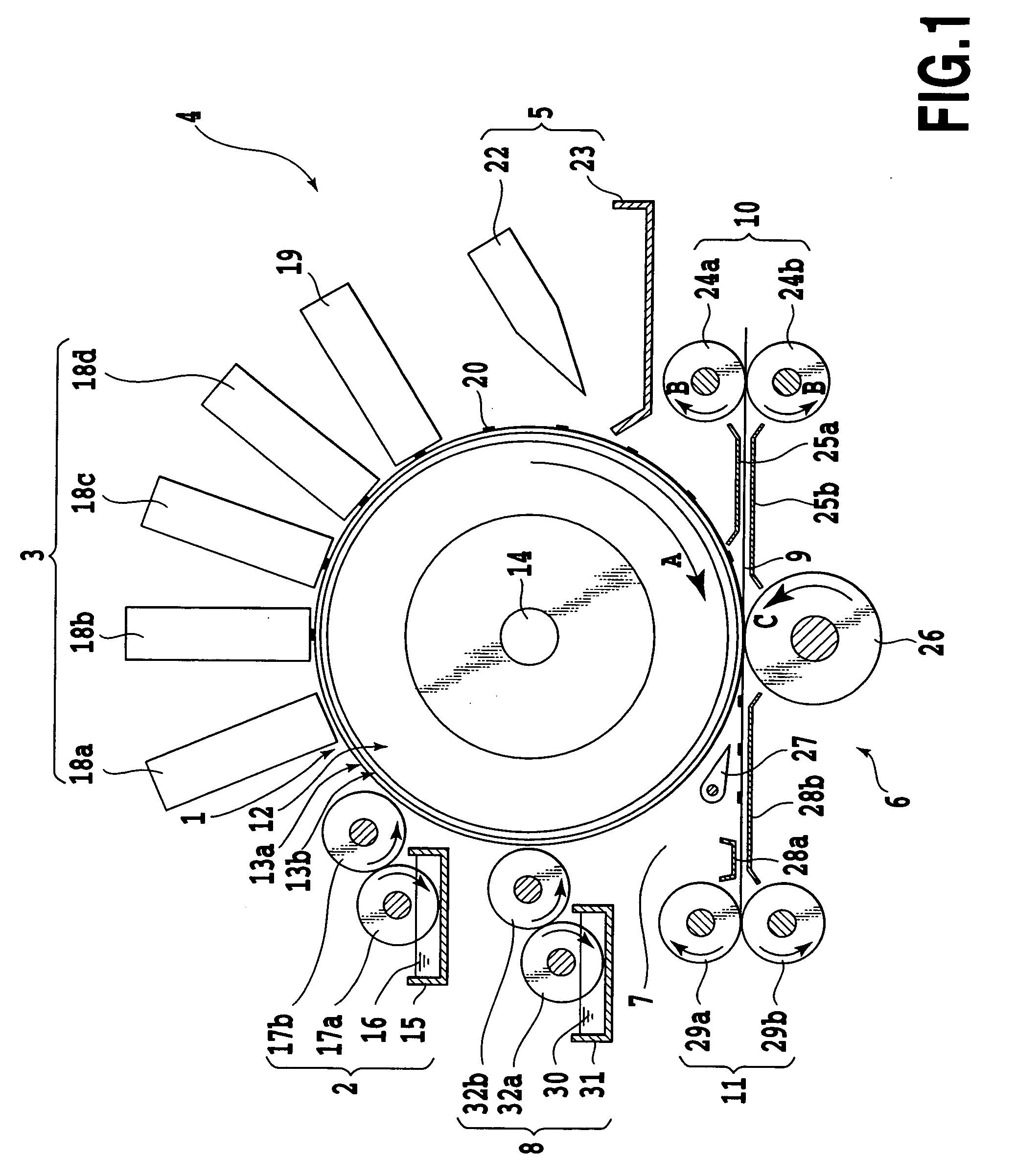Ink jet recording method and ink jet recording apparatus
a recording method and ink jet technology, applied in the direction of railway signalling, transportation and packaging, nuclear engineering, etc., can solve the problems of inability to meet this requirement, inability to meet the requirements of direct ejection system, and the choice of recording medium is subject to strict constraints on the choice of recording medium, so as to reduce the fluidity of ink, suppress beading and/or bleeding, and reduce the moisture of ink image
- Summary
- Abstract
- Description
- Claims
- Application Information
AI Technical Summary
Benefits of technology
Problems solved by technology
Method used
Image
Examples
first embodiment
[0033] In this embodiment, white ink used to alleviate the color and pattern of the recording medium or to highlight the image formed on recording medium is applied to a transfer drum, which functions as an intermediate transfer body, between a step of applying a reaction liquid on to the transfer drum and a transfer step.
[0034]FIG. 1 is a schematic diagram illustrating the configuration of the image formation unit of an ink jet recording apparatus, which embodies the invention in this mode.
[0035] Referring to FIG. 1, a transfer drum 1 is an intermediate transfer body having a releasable surface layer. This transfer drum 1 is supported on a shaft (not shown) and can be driven by a drum drive unit (not shown) to turn in the direction of arrow A. Along the circumference of the transfer drum 1, there are arranged from the upstream to the downstream side in the following order a reaction liquid application unit 2 as reaction liquid applying means to apply a reaction liquid for coagula...
example 1
[0158] In this example, an image was formed by using the ink jet recording apparatus embodying the invention in this mode, shown in FIG. 1. In this image formation attempt, reaction liquid R1 and pigment inks K1, C1, M1, and Y1 prepared as described above were used. First, after the transfer drum 1 was coated with reaction liquid R1 to a thickness of above 2 μm, pigment ink Y1, M1, C1, and K1 were sequentially applied with the recording heads 18 to form a coagulated ink image 20 on the transfer drum 1.
[0159] In this sequence, each pigment ink on the transfer drum 1 was reacting with reaction liquid R1, and an image formed on the transfer drum 1 was found satisfactory, free from beading. Every time the ink of another color was superposed, coagulation immediately took place with no undesired phenomenon of beading or bleeding, and the image formed on the transfer drum 1 was confirmed to have high picture quality.
[0160] Next, white ink W1 was ejected from the white ink applying record...
example 2
[0162] In this example, image formation was attempted on a transparent base by using the ink jet recording apparatus embodying the invention as illustrated in FIG. 3.
[0163] Immediately after the transfer drum 1 was coated with the earlier prepared reaction liquid R1 by the reaction liquid application unit 2, white ink W2 was ejected onto the intermediate transfer body by the white ink applying recording head 19. After that, the recording heads 18 applied pigment inks K1, C1, M1 and Y1 to the transfer drum 1 to form an image on the transfer drum 1. As a result, like in Example 1, a coagulated ink image of high picture quality was formed on the transfer drum 1. That coagulated ink image was transferred to the transparent base, which was the recording medium in this case. The result was satisfactory, with the final printed sheet after the transfer again proving excellent in picture quality.
[0164] This example would prove useful where the image is to be viewed from the side reverse to...
PUM
| Property | Measurement | Unit |
|---|---|---|
| angle | aaaaa | aaaaa |
| critical surface tension | aaaaa | aaaaa |
| surface temperature | aaaaa | aaaaa |
Abstract
Description
Claims
Application Information
 Login to View More
Login to View More - R&D
- Intellectual Property
- Life Sciences
- Materials
- Tech Scout
- Unparalleled Data Quality
- Higher Quality Content
- 60% Fewer Hallucinations
Browse by: Latest US Patents, China's latest patents, Technical Efficacy Thesaurus, Application Domain, Technology Topic, Popular Technical Reports.
© 2025 PatSnap. All rights reserved.Legal|Privacy policy|Modern Slavery Act Transparency Statement|Sitemap|About US| Contact US: help@patsnap.com



